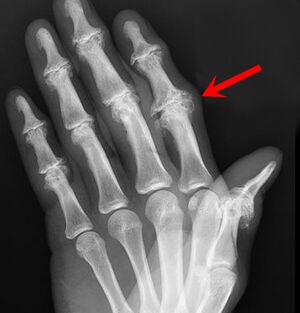Bouchard's nodes
From WikiLectures
Bouchard's nodes are deformities of the proximal interphalangeal joints of the hand (PIP). Like the Heberden nodes, they are a clinical and graphical sign of osteoarthritis. In contrast to Heberden nodes, nodes caused by antibody deposits in synovial fluid may also correlate with rheumatoid arthritis.[1]
Radiographic findings[edit | edit source]
In correlation with the clinic, we find bone nodes at the edges of the proximal interphalangeal joints of the hand - they are often palpable (they may correspond to osteophytes), not always painful. They are less common than Heberden nodes[1].

